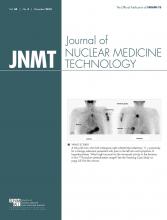Mary Beth Farrell, Ed.
Reston, VA: Society of Nuclear Medicine and Molecular Imaging, 2016, 178 pages
Myocardial Perfusion Imaging 2016: Quality, Safety, and Dose Optimization—an e-book available to SNMMI members free of charge—is an accessible reference for the practicing technologist who wants to quickly look up standard imaging protocols, check appropriate dose and administration for pharmacologic stress agents, or review general principles and common practices. Rather than being written in a scholarly tone (e.g., citing each original research paper or delving into controversies about cutting-edge practices), this book is an easy conversation between technologists about commonly agreed-on practices in nuclear cardiology in 2016.
The stated goal of this publication is to “improve quality, increase safety [of patient care], and reduce radiation burden in MPI,” and the authors set about achieving that goal by reviewing the most basic concepts in perfusion imaging and stress testing. These concepts, when applied properly in the nuclear cardiology lab, result in optimal patient care. In Chapter 1, authors Williams and Reames put into words what every technologist knows but might not be able to succinctly express: why do we do this test, anyway? In a short paragraph entitled “Rationale,” the authors lay the physiologic and scientific foundation for the rest of the book—7 sentences that describe what we do and why we do it. This chapter, like all the chapters, ends with a list of references that points the reader to additional resources if desired.
Chapter 2, “Patient Preparation and Education,” is a solid mix of commonsense advice (helping patients feel more comfortable with nuclear medicine procedures by taking the time to explain them) and critical protocol instructions (nothing-by-mouth instructions, interference from caffeine) that could seriously undermine the results of a study if not followed properly. Bolus and Zimmerman provide two useful tables that reference β-blockers (including generic and brand names) and caffeine-containing medications and substances.
“Stress Testing” (chapter 3), by Mann and Williams, starts with a conversation about why treadmill stress testing is an independent prognostic variable and how it is used in a standardized fashion from site to site (e.g., the Bruce protocol). Pharmacologic stress agents are thoroughly discussed, including dosing, protocol timing, and safety information. The strength of the book is demonstrated by this chapter, in that the authors took a huge volume of scientific research, medical guidelines, and drug development information and distilled it down to the most practical and necessary information for a practicing technologist.
Radiopharmaceuticals for cardiac imaging are discussed in Holbrook’s chapter 4, “Radiopharmaceuticals.” The author summarizes key information about SPECT and PET tracers, providing the fundamentals to technologists who are performing one or the other modality but wish to keep abreast of what is happening across the entire spectrum of nuclear cardiology.
“Quality Control” (Chapter 5 by Farrell and Foster) offers some great visual examples of what can go wrong when you are not paying attention to quality control results. This is an underserved topic in nuclear medicine, often considered unglamorous by working technologists who performs these procedures early in the morning before their “real work” begins. I applaud the editor for dedicating 25 pages of expensive real estate to this potentially boring but ultimately critical topic (including 20 large photographs, some in color).
Chapters 6–8 are the real heart of the matter (pun intended!). In chapter 6, Mantel and Crowley spell out, and diagram, all the commonly used protocols for SPECT and PET myocardial perfusion imaging. These are followed by accepted protocols for assessing viability with both modalities. Acquisition of PET and SPECT images is discussed by Basso in chapter 7, including variables such as collimation, 2 versus 3 dimensions, crystals, and gating. Image processing is covered by Folks, Cooke, and Galt in chapter 8, beginning with reconstruction, continuing with filters, and closing with quantitation. These 3 chapters could be a mini-book in themselves, as they contain all the information required for a technologist to operate a SPECT or PET scanner (albeit not inclusive of vendor-specific software algorithms).
No nuclear medicine publication would be complete without a section on image artifacts, and Pagnanelli in chapter 9 gives us the most common artifacts in SPECT myocardial perfusion imaging along with an explanation of how to avoid them. Although some of the SPECT artifacts are eliminated by the use of PET, particularly attenuation issues, PET/CT can introduce unique artifacts. Additional discussion and case examples of potential PET/CT artifacts would be useful for the next edition.
Chapter 10, on basic interpretation, by Chen and Hajj nicely supplements the technical conversation with an overview of risk stratification, the systematic approach to interpretation and reporting, and a quick discussion of quantitative results. The chapter generously includes 11 case studies, including examples of SPECT and PET, bringing the reader full circle to the impact nuclear cardiology can have on patient care.
Overall, this book is a success—a conversation among highly experienced technologists about how to do myocardial perfusion imaging in the most effective and safe way for the good of patients. It contains the results of decades of cardiac imaging research without the burden of documenting every incremental discovery and overloading the reader with multitudes of references on concepts that have now become general knowledge. The authors of this book are credible and highly experienced technologists, all of whom have contributed countless hours to the American Society of Nuclear Cardiology, the SNMMI, and the field of nuclear cardiology for many years. If I were to choose one criticism to make, it would be that the emphasis on reducing radiation burden in myocardial perfusion imaging was not sufficient to warrant making this one of the book’s three major topics. However, for the purposes of improving quality and safety in patient care, Myocardial Perfusion Imaging 2016 should be taken to heart by the nuclear medicine and PET technologists who perform these procedures. If we all were to follow these instructions, quality and safety would be improved.
Footnotes
Published online Oct. 27, 2016.







